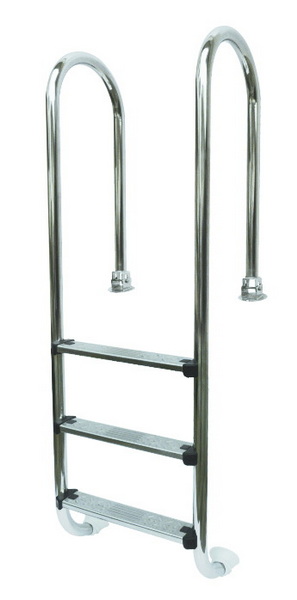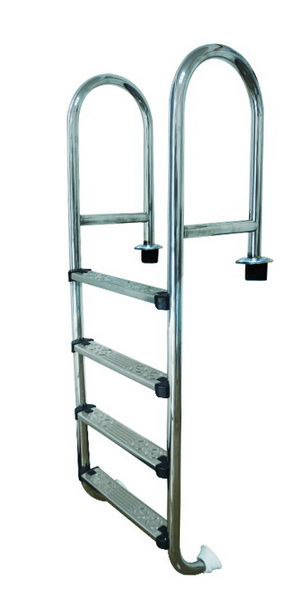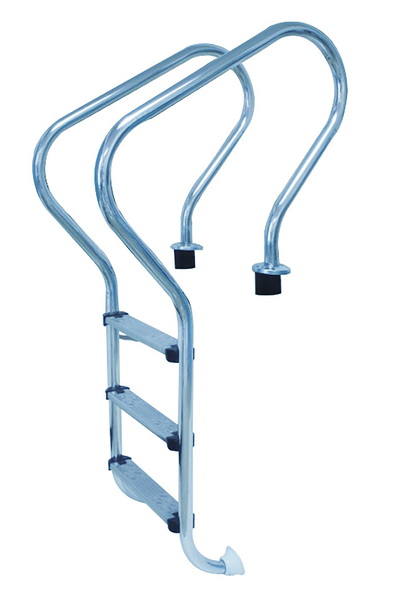Views: 222 Author: Tina Publish Time: 2025-10-30 Origin: Site








Content Menu
● Step-By-Step Guide: Diagnosing Damage
● Preparation: Tools, Materials, and Replacement Parts
● How to Fix a Cracked Ladder Step
● Installing New Steps or Hardware
● Special Fixes: Weighing Down Floating Ladders
● Final Reinstallation and Safety Checks
● Advanced Tips for Pool Professionals
● Troubleshooting Common Pool Ladder Problems
● Safety Warning: When to Replace vs. Repair
● More Repair Tips and Inspiration
>> 1. Can I repair a pool ladder myself or do I need professional help?
>> 2. What type of material is best for replacement steps?
>> 3. How often should I inspect my pool ladder?
>> 4. What if multiple steps break at the same time?
>> 5. How do I prevent my pool ladder from floating?
Swimming pool ladders are essential for safe pool access, yet frequent use and exposure to pool chemicals can cause damage, loose fittings, cracks, and instability over time. Whether you're a pool owner, facility manager, or a contractor serving international clients, learning to repair or replace broken ladders is a vital maintenance skill that preserves safety and functionality. This article explains step-by-step methods to diagnose, repair, and ensure long-term ladder reliability, featuring industrial tips for both DIY hobbyists and technical professionals.[1][2]

Pool ladders commonly break due to several reasons:
- Constant exposure to harsh chemicals like chlorine leads to corrosion and plastic degradation.[3]
- UV rays and fluctuating temperatures cause plastic ladders to develop brittle cracks.[2]
- High-frequency usage, especially in busy commercial pools, accelerates rail loosening and step wear.[1]
- Incorrect installation or poor-quality hardware can result in premature breakage.
Regular inspection and maintenance are crucial to prevent hazards such as slips, lacerations, or accidental falls.
Before embarking on repairs, carefully inspect your pool ladder:
- Look for cracks, fractures, or missing hardware in steps and rails.[1]
- Check if any bolts are corroded, loose, or stuck.
- Test each step for firmness and grip; unstable or slippery treads demand immediate attention.
- Note faded or missing traction surfaces.
Here's a recommended tool list:
- Replacement ladder steps (measure between rails — common sizes are 18", 19", 20").[1]
- Socket wrench and deep sockets (usually 14mm, 1/2", or 9/16").[1]
- Flathead and Phillips screwdrivers.
- Measuring tape.
- Grease or penetrating oil for thread protection.
- Escutcheon plates and boots (optional for in-ground ladders).
- New bolts and nuts.[2]
- Rubber mallet.
Removing the ladder makes repairs more accessible and prevents pool surface damage:
1. Turn off your pool pump and wipe the deck dry for safety.[5]
2. Loosen anchor bolts at deck mounts using a socket wrench.[1]
3. Slide escutcheon plates/boots away from rails.
4. Gently pull the ladder upward, avoiding pressure on vinyl liners; use a partner if the ladder feels heavy.[5]
5. Lay it flat on stable ground near the pool.
With the ladder on the ground:
- Remove nuts and bolts securing the broken step using a wrench or screwdriver.[1]
- If the step is stuck, gently tap bolts with a rubber mallet.
- Leave at least one step installed to preserve spacing, avoiding warping during the process.
Dispose of all damaged steps according to local recycling guidelines.
For minor cracks in polymer or fiberglass steps:
1. Clean the cracked area thoroughly using a pool-safe cleaner.[7]
2. Apply pool-grade epoxy filler with a putty knife, spreading it to fill the crack entirely.[7]
3. Allow to cure as per product instructions; sand lightly if necessary for a smooth, non-slip surface.
4. For deeper fractures or brittle plastic, consider reinforcement with metal mesh or a plastic splint plus screws and adhesive, as recommended by DIY repair forums.[8][3]
For rusted steel ladders:
- Remove rubber/plastic parts for easier access.[9]
- Clean rusted spots with a wire brush, apply rust converter, and repaint with waterproof enamel if needed.
Once damaged parts are off:
1. Align new step with rail holes.
2. Thread bolts through the step and rails, hand-tighten locking nuts for initial flexibility.[1]
3. Insert all steps before final tightening to avoid stress and warping.
4. Confirm snug fit and correct orientation, ensuring any traction grooves face upward.[1]
5. Replace boots/escutcheon plates and re-tighten anchor bolts securely.

Above-ground pool ladders sometimes float or shift. To DIY an effective solution:
- Create custom weights using PVC pipes filled with concrete, sealed at each end, and attached to the ladder sides with cable ties.[6]
- Use teflon tape and thread compound to waterproof joints.
- Attach weights with stainless screws for a durable finish.
For stability, always ensure weights do not block water flow or foster algae growth.
Carefully reinsert the ladder:
1. Lower gently to align rails with deck mounts or anchor sockets.
2. Tighten anchor bolts securely and slide protective covers into place.[1]
3. Fill pool slowly to normal operating level if drained for repairs.
4. Inspect each step by wiggling and pressing — confirm installed stability and grip.
Monthly safety checks and regular cleaning are recommended to prevent recurring problems.
- Inspect bolts and steps monthly for corrosion or cracks.[1]
- Clean steps and mounts regularly to remove debris and calcium.[1]
- Lubricate bolts every 3-6 months for longer life.[11]
- Replace steps immediately if new damage appears.
- Store spare steps in a cool, dry environment.
For commercial pools and OEM brands:
- Keep records of ladder replacement history for compliance.
- Source durable steps with anti-slip grooves and UV resistance for high-traffic areas.[1]
- Train staff to detect early signs of wear and respond quickly.
- Consider bulk purchasing for cost savings.
As a Chinese manufacturer specializing in sand filtration, pumps, and accessories, offering OEM replacement ladder steps can position your brand as a reliable solution provider globally. Invest in advanced tread technology, easy-install designs, and corrosion-resistant alloys to meet international standards.
- Bolt Won't Loosen: Apply penetrating oil, wait 10 minutes, then tap gently to unstick.[11][1]
- Step Won't Fit: Re-measure between rails and confirm thickness before forcing steps.[1]
- Multiple Steps Damaged: Replace the entire set for safety and comfort.
- Worn Anchor Boots: Replace along with steps to protect pool finish.
- Ladder Feels Shaky: Tighten rails and anchor bolts; check step tightness.
Never compromise swimmer safety:
- Replace ladders showing multiple cracks or signs of brittle plastic.[3]
- If repairs seem insufficient or instability persists, invest in a new ladder.
- For professional pools, meet regional safety standards and keep up with product recalls.
- Watch TikTok videos for quick hacks and visual fixes.[12]
- Explore DIY communities for creative reinforcement strategies — aluminum plates, splints, mesh, etc..[13]
- Check manufacturer guides for brand-specific instructions and video tutorials.[14]
Fixing a broken pool ladder restores safe access to your swimming pool and prevents dangerous accidents. By carefully diagnosing the damage, using quality tools and replacement parts, and following detailed repair steps, pool owners and facility managers can efficiently restore ladder functionality. Regular maintenance, prompt replacement of cracked or worn steps, and diligent safety inspections keep your pool environment secure for all users. For OEM manufacturers and global brands, prioritizing durability, easy installation, and commercial-grade safety features ensures lasting customer satisfaction.

Most pool ladder repairs are DIY-friendly if you have basic tools and replacement hardware. However, major structural damage should be handled by pool professionals to ensure long-term safety.[2][3][1]
Heavy-duty polymer, stainless steel, or thick plastic provide the best durability and chemical resistance in pool environments. Avoid cheap plastics that degrade faster under chlorine and UV exposure.[1]
Monthly inspection of steps and bolts is recommended; replace steps or tighten hardware immediately if cracks, fading, or instability appear.[2][1]
Replace all damaged steps together to maintain ladder stability and safety. Group purchasing replacement kits often saves cost and time.[1]
Attach custom weights made from filled PVC pipes to the ladder sides using cable ties and waterproof adhesives for a cost-effective fix.[6]
[1](https://www.poolkingfilter.com/how-to-replace-pool-ladder-steps.html)
[2](https://pool-life.com/pool-ladders-rails-and-steps-resource-guide-pool-contractor/)
[3](https://www.reddit.com/r/fixit/comments/153t161/pool_ladder/)
[4](https://www.shutterstock.com/search/damaged-ladder)
[5](https://www.poolkingfilter.com/how-to-get-pool-ladder-out.html)
[6](https://www.youtube.com/watch?v=Nb82H39bU0g)
[7](https://superiorpoolservice.com/how-to-fix-cracked-pool-steps/)
[8](https://www.reddit.com/r/swimmingpools/comments/1lk8xvq/how_to_repair_a_fiberglass_pool_ladder_step/)
[9](https://www.reddit.com/r/pools/comments/1fmwm9l/how_to_repair_a_rusted_intex_pool_ladder/)
[10](https://www.youtube.com/watch?v=z2tjyznDJek)
[11](https://www.poolkingfilter.com/how-to-remove-a-stuck-pool-ladder.html)
[12](https://www.tiktok.com/discover/fix-broken-pool-ladder)
[13](https://www.facebook.com/groups/637529959937311/posts/2618402638516690/)
[14](https://blog.watsons.com/blog/stabilize-above-ground-pool-ladder)
[15](https://www.reddit.com/r/fixit/comments/1lgxx8a/broken_pool_ladder/)
[16](https://blog.watsons.com/blog/remove-above-ground-pool-ladder)
[17](https://coconutjacks.com/items/Replacement-Swimming-Pool-Stainless-Steel-Replacement-Ladder/610762)
[18](https://www.reddit.com/r/swimmingpools/comments/v0m94f/just_saw_our_pool_stairs_have_begun_to_crack_is/)
[19](https://diy.inyopools.com/video/how-to-remove-a-stuck-inground-pool-ladder/)
[20](https://diy.inyopools.com/article/psc-ep-57-remove-stuck-inground-pool-ladder/)
